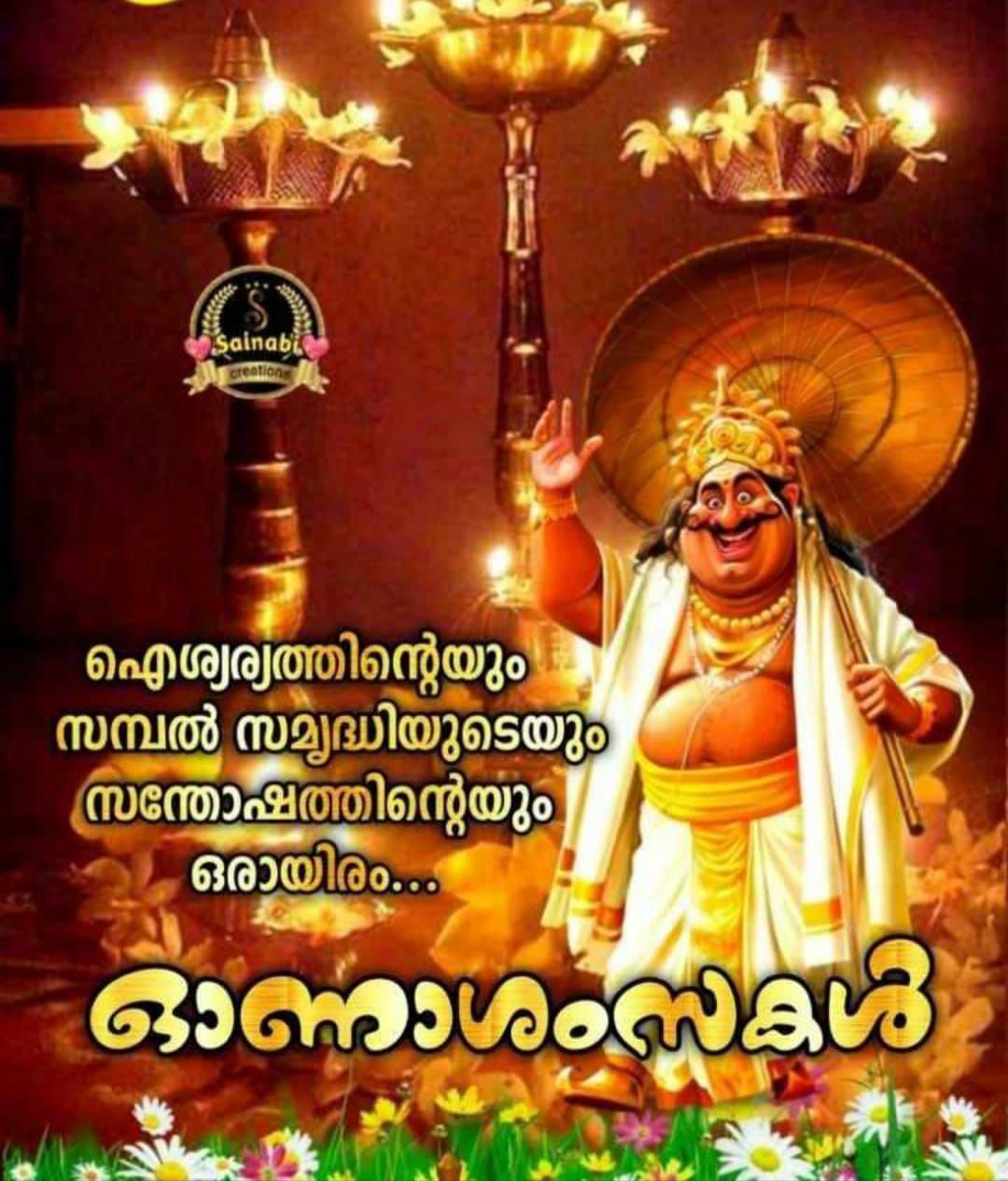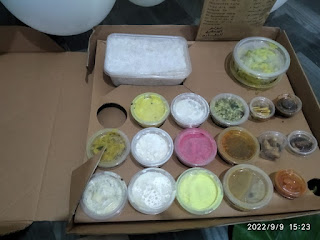Ref: Journal of Dharma 47, 3 (July-September 2022), 355-374 © 2022 Journal of Dharma: Dharmaram Journal of Religions and Philosophies (DVK, Bangalore), ISSN: 0253-7222
CELEBRATING SUSTAINABLE PROSPERITY: Onam as Earth Festival
Onam - where did the word come from? Of course, in Malayalam calendar, there is a star by name 'Thiruvonam', (apparently a derivation from the Sanskrit 'shraavan' star indicative of Lord Vishnu, and the prefix, 'thiru' indicative of holiness/respect due to the deity. https://www.kerala.com/pages/onam-in-kerala) and Onam is celebrated on the Thiruvonam day of the Malayalam month of Chingam (the first month), usually falling somewhere in the second half of August or first half of September.
Since when this was being celebrated - we do not know for sure. Some sources indicate it being celebrated from the historic Sangam era. 16th century onwards, there have been travellers from beyond the subcontinent making references to it.
It was a festival, usually within the hindu family circles, which was 'emancipated' as the 'national' festival of Keralam, (if there is ever a 'nationality' of Keralites, definitely distinct from the rest of the world as far as language and culture are concerned) by the communist government of Keralam.
Being a Kochiite, I am happy that Onam celebrations have their focus in and around Kochi - I think Thrikkakkarayappan, with his seat at what used to be a very small temple in my childhood, is none other than Mahabali. (But there are also versions that refer to the deity as Vamana - Vishnu or even, as Siva). Mahodayapuram Perumal who ruled from Thrikkakkara (Thrikkakkara, in my childhood, happened to be a wilderness with hardly any population or anything of a 'civilisation' for normal human understanding - wild bushes, some estates, a hilly area for us who used to live in the level coastal area of Kochi, hardly anything to connect to some Perumal being anywhere there), is said to have celebrated Onam from Thiruvonam of Karkidakam till Thiruvonam of Chingam, with 56 rulers of princely states - and when their coming to Thrikkakkara was found to be difficult, it was ruled that the celebration could be held at each one's household, leading to the household based celebration of Thrikkakkara Appan. https://www.keralatourism.org/onam/onam-rituals/thrikkakkara-appan-rituals
Then we have the modern day popular celebration of attacamayam centred around Thrippunithura - again part of the Kochi, with the deity being honourably taken from there to Thrikkakkara in solemn procession.
Onam, the waking up of the land of Keralam to its spring time, after the deprivations of Karkidakam (kalla Karkidakam), is presented with the mythological good governance figure of Mahabali, said to have ruled from Thrikkakkakara. His greatness was seen as a threat by 'gods' that they needed the intervention of the Sustainer God Vishnu, to let the balance be (i.e., the status quo). It is sometimes painted as an Aryan-Dravidian conflict. But it definitely is indicative of the human potential to grow to the stature of God - a God-becoming possibility.
I am glad for the apparently exploitative God-deal, in which Mahabali epitomizes the possibilities in human generosity to the extent of losing oneself, and in the very act obtaining immortality - in the memory of his people forever, and even the liberated status to come back from the confines of the pataal with his annual legendary visit (now almost taking the modes of a hilarious Christmas Papa).
Is it the celebration of a golden past? There was hardly ever such a past - I feel things are better now; the Onam as it increasingly becomes a community celebration, even the liberation of Onam itself from an exclusive celebration of culture confined to Hindu fold, to a very adaptive cultural celebration by a people, and by all religions, if they want to. (40 years ago, there was hardly any common celebration of Onam in our locality - there was hardly any mention of it in the school, except in connection with the terminal examinations and the vacation; nor did the churches have anything to do with it. This is drastically changed. I observe that all educational institutions devote at least one working day in celebrating Onam. It does promote fellowship among the students and teachers and sometimes, extends to parents as well. All the Kerala churches (even, the Churches of Malayali diaspora all over the world) celebrate Onam enthusiastically. These are very positive signs of the new era).
But, the point is, it is the celebration of the future, the dream in every human being (every Indian) of a reign of law - of equality, of liberty, of fraternity, of a corruption free, just, caring and prosperous rule - of the much spoken of good governance.
It should be the celebration of the basic culture in the progress of human civilsation - of agriculture; It is typically a harvest feast, when the rice crop is harvested, along with the tubers planted during the kumbham (Vishu season) become ready for harvest - and fittingly celebrated with the sadya, the feast. Hence to my mind it is a 'food festival' and the right time to celebrate the traditions of food of the region, and its new permutation-combinations (like the entry of the foreigner cabbage as a regular item of sadya for quite some time now; another foreigner beetroot and the migrant kappa - tapioca - are making gradual wildcard entry into the sadya-menu: I was surprised to find chicken being solemnly served, when I joined a North Kerala family for their Onam lunch; and they assured me that it was a practice in their region).
The simple, minimalist life-style of Keralites (the normal dress of men used to be just a mundu - the unique wrap-around cloth that served the climatic conditions best), with hardly anything to cover the top, except a randam mundu (a second piece of cloth) used for covering the torso, on solemn occasions, the minimalist dress of the women folk, the bare minimum of diverse and frugal food (chakkengm mangegm mummaasam, thalum thakarem mummaasam, chempum chenem mummasam, anganem inganem mummasam. 3 months on jackfruit and mango, 3 on colocasia and yams, another 3 on leafy vegetables freely available around and the rest of the three, somehow or other! The lines are indicative of frugality and a diversity dependent on the environment). The entire landscape of Kerala does not show any signs of very great accumulation of wealth with anyone for that matter. There might have been kings and landlords - but even their palaces do not evince any sign of opulence that we are now becoming more familiar with, or the North Indian regions of India are familiar with. From that culture of very simple living on the whole, Kerala population now exhibits a highly consumption oriented (maximalist) culture, with wealth increasing, and consumption affordable, and a trend of increasing accumulation with certain people. What I feel concerned about is the trend impacting the planet, with increasing pollution from emissions and also from (unmanaged) solid waste.
Coming back to its being a food-festival - it implies food production; and hence it should be the celebration of the food producer - Jai Kisan - is a mere slogan now, Jawan has grown in prominence; whereas, Kisan's life has become one of indignity, oppression, express and hidden oppression - there is no platform, no education that promotes the dignity of food production and producer; no mainstream education or educator or policy maker ever imagines that this is to be one of the important career options; or encourages youngsters to look at this as a career option. While, all politicians wax eloquent about farmers, no party or government does anything to promote this as a dignified occupation/profession; and people continue to produce since they are left with no option. Given an option, they would all quit. I have travelled across the country, I have hardly met any teacher, hardly met any student (honestly, with some rare exceptions), who think in terms of agriculture as a career option. At least for the state of Kerala, it is high time, that government went beyond the stereotypes, and made the vast network of their agricultural department vibrant, supportive, flexible, people friendly and productive, not being satisfied by the propagandist and token revival (grow-bag) attempts, including localised procurement and fair price for the producer.
Food is produced only by earth - though now there are successful attempts to produce without earth - but not sure of its feasibility on a large-scale. It is the mother earth that produces - with the right combinations of soil, air and water, with sunshine. Each onam is a time for veneration of productive mother earth! And a resolve to maintain it, especially by 'protecting soil and its health'. And also challenging every consumer to be a producer as well - or at least all homesteads to produce minimally (family farming ideal).
I find the religious aura for the festivities apt - It is linking our celebration to the ultimate annadata - food giver - God; and aptly so when the celebration implies solidarity with people deprived of food (God's own children and hence brothers and sisters). Today (Sep. 2022) we have millions in Pakistan, Afghanistan, Sudan, Somalia (floods); Srilanka, Many parts of Africa deprived of food on account of civil strifes, besides the regular millions of India. Onam is indicative of the egalitarian abundance possible through just sharing of the planet's resources.
Harvest at this point of time may be a unique feature of the state of Keralam or perhaps of the western coast; but the model of liberating and elevating it to a food-harvest-kisan-earth festival can be model for the whole nation, and worth considering it as a national festival, not a mere Malayalee festival celebrated all over the nation or the world!
To me, as a feast, without explicitly saying so, it incorporates very core of sustainable development goals - zero poverty (SDG 1), no hunger (SDG 2), good health and well being (good food, and not medicines, for good health - SDG 3), clean water and sanitation for all (water as part of food, and waste reduction for sanitation - SDG 6) and responsible consumption and production (SDG 12).





A detailed description. It's a reference. Value the pain taken for such an elaborate write up. ഉമ്മ
ReplyDelete